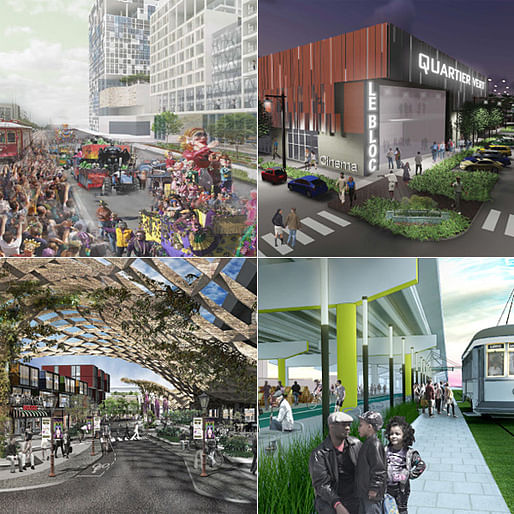
Founded by Gerald D. Hines, the annual Urban Land Institute Hines competition challenges multidisciplinary graduate student teams from North American universities to propose a comprehensive redevelopment program for a designated U.S. metro area. The ideas competition is set up as a design exercise with no plans of implementation, but the hypothetical situations of the brief are largely based on actual urban development and redevelopment scenarios, so students get to test their design skills in relevant real-world issues. What student wouldn't be motivated by that?
For its 13th edition, the competition focused on the Tulane/Gravier and Iberville neighborhoods in downtown New Orleans that were affected by Hurricane Katrina.

2015 ULI Hines finalists (starting on the L, clockwise): Harvard University: “Tremé 2.0”; University of Wisconsin - Milwaukee and University of Wisconsin - Madison: “Quartier Vert”; Harvard University: “Claiborne Grove”; University of Maryland: “The Crossing”
The competition started with 120 teams of 600 grad students from 60 universities and then narrowed down to four finalists. The University of Maryland team scooped the $50,000 grand prize for the second consecutive year after presenting their proposal, "The Crossing", in New Orleans. The three other finalists who also presented included two teams from Harvard GSD and one from the University of Wisconsin - Milwaukee and the University of Wisconsin - Madison. Each finalist team received $10,000.
More details about The Crossing below:
"It proposed developing a high-quality main street on Derbigny and phasing in diverse housing stock at an appropriate urban scale. In the master plan, new development would support active programming under I-10, ensure affordable housing, and improve the area’s storm water infrastructure."



"Final phases of the plan reinforced the community-oriented approach. A proposed bus rapid transit worked to improve accessibility for historically disadvantaged communities along North Claiborne Avenue. The ramp relocation and subsequent redesign of Basin Street would unify the Lafitte Greenway and Louis Armstrong Park. Within the newly continuous green space, the Resilience Center symbolizes the essence of the proposal by bringing natives and visitors together to create an improved future for the city and its residents."
No Comments
Block this user
Are you sure you want to block this user and hide all related comments throughout the site?
Archinect
This is your first comment on Archinect. Your comment will be visible once approved.